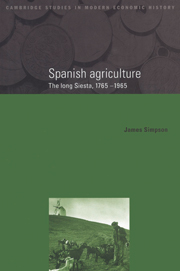Book contents
- Frontmatter
- Contents
- List of illustrations
- List of tables
- Acknowledgements
- Note on the regional division of Spain
- Abbreviations and conventions
- Introduction
- Part I The relative backwardness of Spanish agriculture
- Part II Traditional technologies and market opportunities, 1765–1880
- Part III The limits to technical change, 1880–1936
- Part IV Markets and institutions, 1880–1936
- Part V The State and the end of traditional agriculture
- Conclusion
- 12 Spanish agricultural change in a European context
- Appendix Estimates of agricultural output and consumption in nineteenth-century Spain
- Bibliography
- Index
12 - Spanish agricultural change in a European context
Published online by Cambridge University Press: 04 December 2009
- Frontmatter
- Contents
- List of illustrations
- List of tables
- Acknowledgements
- Note on the regional division of Spain
- Abbreviations and conventions
- Introduction
- Part I The relative backwardness of Spanish agriculture
- Part II Traditional technologies and market opportunities, 1765–1880
- Part III The limits to technical change, 1880–1936
- Part IV Markets and institutions, 1880–1936
- Part V The State and the end of traditional agriculture
- Conclusion
- 12 Spanish agricultural change in a European context
- Appendix Estimates of agricultural output and consumption in nineteenth-century Spain
- Bibliography
- Index
Summary
Between about 1750 and 1950 Spanish agriculture successfully increased its output to feed a population which had tripled in size. Furthermore, by the 1880s the supply of food from one year to another remained fairly constant, and price fluctuations for consumers were considerably less than they had been only a few decades earlier. Yet, even in the early 1950s, Spain was still a poor country. It was poor, both because a large share of its active population was employed in agriculture, and because the levels of productivity in the sector were conspicuously below those found in richer countries. Thus, in 1950, half the active labour force was still employed in agriculture, only a quarter lived in urban centres of more than 100,000 inhabitants and agriculture's share of GDP remained at about 30 per cent. However, perhaps the most conspicuous evidence of the ‘failure’ of agriculture was to be found in people's diets. These were high in carbohydrates and low in animal protein, with the quantity of calories consumed per capita/day derived from milk, meat, fish and eggs being only 250 in southern Europe compared to 940 in northern Europe in the mid-1950s. Furthermore, to obtain this poor diet, the inhabitants of Italy, Greece, Spain and Portugal spent about 40 to 50 per cent of their per capita income on food, compared to only 30 to 35 per cent in northern Europe.
- Type
- Chapter
- Information
- Spanish AgricultureThe Long Siesta, 1765–1965, pp. 265 - 279Publisher: Cambridge University PressPrint publication year: 1996



